
The Fokker Dr.I, often known simply as the Fokker Triplane, was a World War I fighter aircraft built by Fokker-Flugzeugwerke. The Dr.I saw widespread service in the spring of 1918. It became famous as the aircraft in which Manfred von Richthofen gained his last 17 victories, and in which he was killed on 21 April 1918.

The Fokker D.VII was a German World War I fighter aircraft designed by Reinhold Platz of the Fokker-Flugzeugwerke. Germany produced around 3,300 D.VII aircraft in the second half of 1918. In service with the Luftstreitkräfte, the D.VII quickly proved itself to be a formidable aircraft. The Armistice ending the war specifically required, as the fourth clause of the "Clauses Relating to the Western Front", that Germany was required to surrender all D.VIIs to the Allies. Surviving aircraft saw much service with many countries in the years after World War I.

The Fokker E.V was a German parasol-monoplane fighter aircraft designed by Reinhold Platz and built by Fokker-Flugzeugwerke. The E.V was the last Fokker design to become operational with the Luftstreitkräfte, entering service in the last months of World War I. After several fatal accidents due to wing failures, the aircraft was modified and redesignated Fokker D.VIII. Dubbed the Flying Razor by post-war pulp-fiction writers, the D.VIII had the distinction of scoring the last aerial victory of the war.
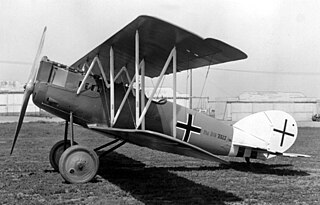
The Pfalz D.XII was a German fighter aircraft built by Pfalz Flugzeugwerke. Designed by Rudolph Gehringer as a successor to the Pfalz D.III, the D.XII entered service in significant numbers near the end of the First World War. It was the last Pfalz aircraft to see widespread service. Though the D.XII was an effective fighter aircraft, it was overshadowed by the highly successful Fokker D.VII.

The Fokker V.6 was a prototype fighter triplane developed in Germany during World War I in parallel with the V.5, from which the famous Dr.I was developed. The V.6 was powered by an 89 kW (120 hp) Mercedes D.II liquid-cooled engine. The heavier engine required larger wings, with the lower wing being placed just below the fuselage. A modification to add fairings to the lower wing fuselage junction was implemented after the first tests. The V.6 was abandoned in October 1917 due to being inferior in maneuverability to the newer Dr.I.

The Fokker V.7 was a prototype German fighter triplane of World War I, an attempt to improve upon the Dr.I by using the experimental Siemens-Halske Sh.III, double acting rotary engine.. To make use of the higher power and rpm, the aircraft had a four-bladed propeller of larger diameter than the Dr.I. This required longer landing gear. The rear fuselage had to be extended to compensate for the heavier engine. Four V.7 aircraft were built. The performance of the V.7 was outstanding, but the engine was not ready for service. The Fokker V.7/I was converted to a Dr.I.

The Fokker V.1 was a small German sesquiplane experimental fighter prototype built in 1916 by the Fokker-Flugzeugwerke. Sporting a parasol wing, it was the first Fokker aircraft purportedly designed by Reinhold Platz—the respective roles played by Fokker himself, Platz, and possibly others in the conceptual design of Fokker airplanes are a matter of dispute among historians—and was an early experiment in cantilever wing construction, eliminating the bracing wires typical of aircraft design at the time, something that had already been achieved with metal materials in Hugo Junkers' own pioneering Junkers J 1 in 1915.

The Fokker V.2 and V.3 aircraft were developed from the Fokker V.1, but utilized an 89 kW (120 hp) Mercedes liquid-cooled inline engine instead of the rotary. This is similar to the Fokker V.6 being tested as the Fokker V.5 was being developed. Like the V.1, the fuselage was circular in cross section, and the wings were covered with plywood. To match the center of pressure and center of gravity with the heavier engines, these aircraft had their upper wing's outboard sections swept back.
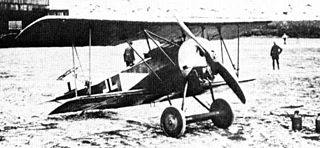
The Fokker D.VI was a German fighter aircraft built in limited numbers at the end of World War I. The D.VI served in the German and Austro-Hungarian air services.
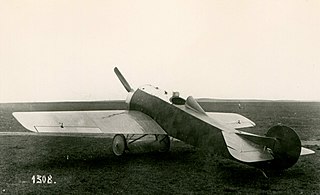
The Fokker V.17 and its derivatives were a series of experimental monoplane Fighter aircraft produced by the Dutch aircraft company Fokker in the 1910s.

The Fokker V.9 was part of a series of experimental aircraft which led up to the low-production D.VI fighter. The aircraft were very similar, varying in detail and power plants.

The Fokker V.39 was a prototype sports aircraft built by Fokker shortly after World War I based on a scaled-down version of the Fokker D.VIII fighter design and powered by an 82 kW (110 hp) Le Rhône engine.
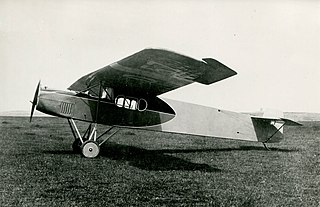
The Fokker F.II was the first of a long series of commercial aircraft from the Fokker Aircraft Company, flying in 1919. In a biplane age, it presented a distinct clean, high-wing monoplane style that sold successfully across Europe and North America during the development of commercial passenger-carrying aviation.

The Junkers D.I was a monoplane fighter aircraft produced in Germany late in World War I, significant for becoming the first all-metal fighter to enter service. The prototype, a private venture by Junkers named the J 7, first flew on 17 September 1917, going through nearly a half-dozen detail changes in its design during its tests. When it was demonstrated to the Idflieg early the following year it proved impressive enough to result in an order for three additional aircraft for trials. The changes made by Junkers were significant enough for the firm to rename the next example the J 9, which was supplied to the Idflieg instead of the three J 7s ordered.
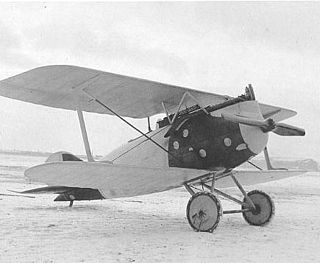
The Rumpler D.I was a fighter-reconnaissance aircraft produced in Germany at the end of World War I. It was a conventional single-bay biplane with wings of unequal span braced by I-struts. It featured an open cockpit and a fixed, tailskid undercarriage. The upper wing was fitted with aerodynamically balanced ailerons and fuselage had an oval cross-section.
The Kondor E 3, sometimes erroneously known as E.III, was a German single seat, monoplane fighter aircraft designed and built close to the end of World War I. Though successful in the third D-type fighter competition at Aldershof in September 1918, only a few were produced, given the Idflieg designation of Kondor D.I.

The Kondor D 7 was a prototype German single seat biplane fighter built over the winter of 1917-18. It was not a success and its development was soon abandoned.

The Zeppelin D.I, or Zeppelin-Lindau D.I or Zeppelin D.I (Do), as named in German documents, also sometimes referred to postwar as the Dornier D.I or Dornier-Zeppelin D.I, for the designer, was a single-seat all-metal stressed skin monocoque cantilever-wing biplane fighter, developed by Claude Dornier while working for Luftschiffbau Zeppelin at their Lindau facility. It was too late to see operational service with the German Air Force (Luftstreitkräfte) during World War I.
The DFW D.I was a German fighter aircraft produced during World War I.
The DFW Dr.I was a prototype German fighter aircraft built during World War I.

















